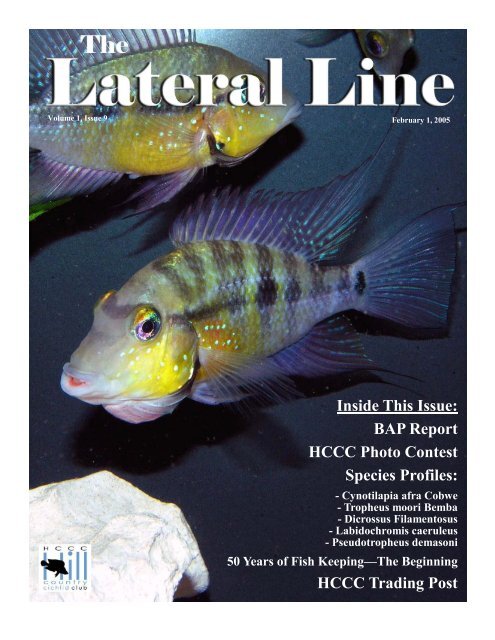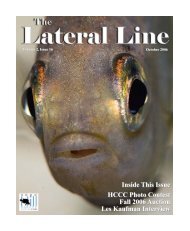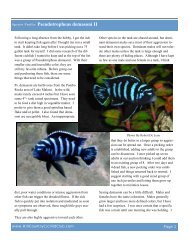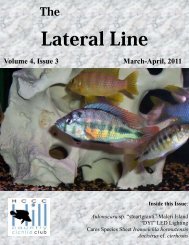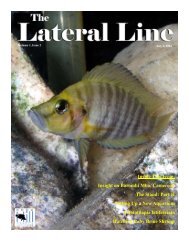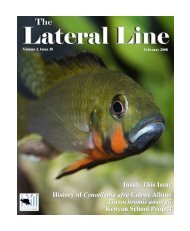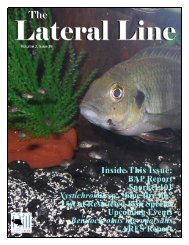February - Hill Country Cichlid Club
February - Hill Country Cichlid Club
February - Hill Country Cichlid Club
- No tags were found...
Create successful ePaper yourself
Turn your PDF publications into a flip-book with our unique Google optimized e-Paper software.
The Lateral Line Page 5AuloncarajacobfreibergiBy Terry IsbellNimbochromis venustusBy Greg and Lee Ann SteevesOtopharynx lithobatesBy Greg and Lee Ann SteevesProtomelas stevensiBy Terry IsbellInterview with Jessica MillerBy Dave HansenDave: How did you get your start in fishkeeping andhow long ago?Jessica: I started fishkeeping while living in Coloradoin 1996. I think I really just didn’t have much else to doat the time and <strong>Cichlid</strong>s intrigued me so I bought abunch of books and a tank and things pretty much tookoff from there.Dave: I understand you have a particular passion fortropheus. How did this develop?Jessica: Also, while in Colorado, there was a fish storethat specialized in Rift Lake <strong>Cichlid</strong>s that had a numberof amazing Tropheus tanks and I was just very takenwith their unusual appearance. Not long after, I learnedhow difficult they can be and this made them all thatmore interesting to me.Dave: What is your current setup as far as tanks andtypes of species you are keeping?Jessica: Er, do you really want to know? I have a3500gallon pond with Koi. For a number of personalreasons, I have not kept indoor fish for the past fewyears. My last tanks were of Tropheus (100g’s, 75g’sand 55g’s) and Frontosa (250g). I don’t intend for thisto be a permanent situation, just what needs to be fornow.Dave: As someone who has written some articles, isthere anything you are currently working on or has aspecial interest for you?Jessica: Not at the present time, though can I plug myfriend Frank Schneidewind’s brand new TropheusMiniAtlas (German language)? It’s amazing!Dave: If you don't mind tell us about yourself outsideof fishkeeping?Jessica: How much do you want to know? Being theobsessive person that I am, after selling my fish Ilaunched into keeping cacti and now maintain a greenhousefull of them. I have worked for a software companyin Seattle for nearly 10 years on mainframe andAS/400 systems and doing emulation support, and liveEast of Seattle in a town called Issaquah with my husbandand two cats.
The Lateral Line Page 6Species Profile: Cynotilapia afra ‘Cobwe’Background:Cynotilapia were first described by Gunther in 1893 asbelonging to Hemichromis. Reagan, in 1922, describedthis genus again using its unusual dog-like dentition forthe genus name. Cynotilapia means dog tilapia in Latin.“Representatives of Cynotilapia have long, wellseparated,unicuspid teeth, strongly conical in the outerrow. The teeth of the inner rows are smaller and irregularlyspaced.” [1] Cynotilapia afra was the only describedspecies for many years. However, in recent decadeswork has progressed and thereare approximately a dozennamed species. I personallythink the afra group will eventuallybe sorted out and a fewnew species named. The localevariant I have is from the eastern(Mozambique) shore ofLake Malawi, just about at thecenter the lake at Cobwe. Ihave used Konings spelling,but have seen this spelled‘Cobue’ many times. The correctpronunciation is a little elusiveas well: CO-BOO or COB-WAY. This variant has beensold in the hobby as “Orange Back Afra”, “OrangeBack Cobue” and “Afra Edwardi” . “C. afra has settledin virtually every rocky or intermediate habitat….withmales defending small caves among the medium sizerocks. C. afra has even establisheditself in sediment-richhabitats such as….Cobwe.” [2]Typical water parameters,aquascaping, and diet forMbuna apply. Adult size formales is 3 to 3-1/2” with thefemales being slightlysmaller.Photo By Chiu Lee— by Nick Andreola(Sharkie) several months ago. They were placed in a 45gal breeder tank with a quad of Ps polits, a group of six1-1/2” Lab. Perlmutts and a couple of dwarf bristlenosecatfish. The male afra is the undisputed king of thetank. Not even the male polit will attempt to challengehim. A closer look at his face shows the probable reason---thisguy has some serious looking chompers andhe likes to show them off. He is about the same lengthas the male polit but has a deeper, thicker body. Hiscolor intensity tends to follow his moods. When hestruts his stuff, he is gorgeous.The F0 females are reasonablyattractive with a solid lightblue body and hints of black inthe tail and dorsal fins. I thinkthat using an actinic light bulbenhances their looks. The F1female is intriguing. Sheshows faint black barring andoccasionally you can see someyellow coloration on her headand shoulders in the typicalmale pattern. Her fry have aunique look as well. I will be experimentingwith her line to try to capture and hopefullyenhance this female coloration trait. The male isgenerally sedentary. No matter how or how often youRiver City Aquaticsa proud supporter of the HCCCMember discounts:25% off livestock15% off dry goods / 10% off aquariums(Continued on page 7)Personal Experiences:I first received an adult F0 trioand an F1 female from fellowHCCC member Chiu Lee12108 Roxie Dr., Suite DAustin, TX(512)219-7200
The Lateral Line Page 7change up the rockwork, he will choose a ‘cave’, makea pit in the substrate, and hover near his turf. He comesout to swim with his harem on occasion and rockets tothe surface at feeding times. He doesn’t chase trespassersfor any distance like other territorial males I’vekept. Once the interloper is out of his small domain, hereturns to his cave. All the other fish generally respecthis turf. The females are a little more territorial than Iexpected but, are generally very peaceful and join withthe female polits and young perlmutts in leisurelyswims in the mid and upper waters.Conclusions:I highly recommend C. afra ‘Cobwe’ to anyone with aninterest in Mbuna. They are undemanding, colorful andprolific breeders. While the male will determinedlydefend his territory, the actual territory is small and themale does not exhibit the same type of random, constantaggressive behavior as a Ps. Polit or a Ps. Demasoni.Species Profile: Tropheus moori Bemba Orange Flame— by David DockwillerTropheus moori Bembas are native to Lake Tanganyika.In the <strong>Cichlid</strong> trade Tropheus moori Bembas areknown has Orange Flames. In their natural habitat OrangeFlames can be found in rocky areas in Lake Tanganyika.In the aquarium environment Tropheus lovemoving through the various openings in the rock formationsthat I had in my 75 gallon tank, as well as, eatingalgae that grew on the rocks. I obtained six OrangeFlames from Armke's Rare African Fish located inNew Braunsfels, Texas. When I acquired them theywere approximately 1" long. When young, OrangeFlames are a blackish grey with a light vertical orangemarking located in the middle of the body. In adulthood,Orange Flames acquire a body that is deep blackwith a pronounced orange vertical band on the middleof the body. Their bodies are torpedo shaped with thehead being larger and very round. Coloration in bothmales and females is virtually the same with the dominantmale having a more distinctorange band. Tropheushave a reputation for beingvery aggressive and veryactive in the aquarium environmentand should not bekept with more peacefulcichlids. I have noticed aggressivebehavior on manyoccasions, which is why Iwill state that anyone wantingto maintain Tropheusshould have a colony with atleast 12, or unless the aquariumthey will be housed in is large (6 feet in length orgreater) a fewer number can be maintained. The aquariumshould also have many hiding places so that lessdominant Tropheus can recover from any bullyingmales or females. It should also be noted that alongwith Orange Flames I kept other types of Tropheus inthe same tank. At the time all of my Tropheus werekept in a 75 gallon tank.I have had three successful spawns with OrangeFlames. Two of the spawns occurred in my 75 gallontank and the last spawn, which I will write about in thisarticle, occurred in my 240 gallon tank. I was able toraise 5 Orange Flames from each spawn. Each spawnproduced approximately 12 eggs. When I acquired the240 gallon tank last Spring I had already decided to getAmazonia Internationala proud supporter of the HCCCMember discounts:20% off Fish & Live Plants10% off Tanks, Stands, Eheims and Eclipses25% off Filters and Powerheads4631 Airport #116Austin, TX (512) 451-0958(Continued on page 8)
The Lateral Line Page 8rid of all of my Tropheus with the exception of my OrangeFlames. I placed all six of them in the 240 gallonaquarium, noting that the size of the tank should displacethe aggression has previously noted. After placingthem in their new home I noticed that 1 of the OrangeFlames was not eating, of course I realizedquickly that I had a problem. I tried to medicate thesingle Orange Flame but to noavail he soon perished. I endedlosing 3 others to the dreadeddisease (we all know which diseaseI am referring to) leavingme with only 2 survivors, a lonemale and female. I believe thelosses occurred because the tankwas new and was not completelyestablished. In addition,the substrate is very difficult toclean since the size of the Aragonitegrains are quite small andtend to be picked up by the siphonquite easily. Tropheus need very clean tanks andthe substrate needs to be siphoned to remove a largemajority of the detritus. It was devastating for me tolose my Orange Flames since they had been under mycare for two years. Needless to say, my single pairspawned. I ended up losing the male shortly afterwards.However, I waited and noticed that the femalewas holding for quite some time, unfortunately she wasnot holding long enough before I stripped her of heryoung. I noticed that a considerable amount of the yolksack was still remaining. Out of the 12 fry I was onlyable to raise 5 successfully. I believe the survival ratewas low because the fry were not kept in a capacity thatwould allow them to be 'tumbled' with a large amountof aeration. If I had 'tumbled' the fry I might have hada higher survival rate. I have found that when there is aconsiderable amount of yolk sack remaining on fry,fungus is able to envelop the yolk sack, which can leadto a premature death.The 75 gallon has a substrate that is a light brown androunded with no sharp edges, which is perfect for Tropheus.The substrate is used in commercial applicationsas blast sand. The substrate in the 240 gallon isAragonite. Both aquariums have holey rock for shelterand hiding places. Neither tank has live plants or plasticplants. Both tanks are filtered by Eheim 2217's.The temperature in both tanks is maintained between78 and 80 degrees Fahrenheit. The pH in the tanks isunknown since I have never tested the water. I performweekly water changes equal to 15% of the tank volume.I use fluorescent lighting for duration of approximately14 hours each day. Ifeed my cichlids New LifeSpectrum pellet and Ocean Nutritionflake.The spawning habits of OrangeFlames can at times be aggressive.The male will chase thefemale until she is ready tospawn. In some instances Ihave had to remove the femalebecause the damage inflicted onthe female was extensive.Photo By Spencer JackWhen Photo a spawn By Greg does Steeves occur themale flutters, shakes, and shimmiesaround the female to entice her to spawn. Thefemale will then release an egg to be immediately takenup by the female. The spawn will occur in the open.What is interesting about the spawn is that other cichlidswill not intervene in order to make a meal of theeggs once laid by the female. I have a dominant maleCyrtocara moori that bullies other males when spawningin the 240, but for some reason he will not interferewith the Tropheus. The process will usually yieldabout 20 eggs by my estimates. The eggs of Tropheusare quite large which is why Tropheus spawns do notyield great numbers. The eggs are cream colored inappearance. The female will hold the eggs for approximately3-4 weeks. I have noticed that the female willtake little bits of food during the incubation processwhich is something that is not too common with femalecichlids. I will strip the female of her babies once Ithink the time is ready for the babies to feed on theirown and will be safely raised in a fry tank (howeverduring the last spawn I obtained the fry prematurely).The fry are quite large after release and are light black/grey with a very subtle band that is a light grey in themiddle of the body. I have noticed that Tropheus fry(Continued on page 9)
The Lateral LinePage 9grow very quickly over time. In 2months they can obtain a size that isclose to 1", whereas it will take my Calvusat least 9 months to obtain a size thatis close to 1". The fry tank uses asponge filter for filtration and the fry arefed crushed flake food. I have also recentlystarted feeding the fry freeze driedDaphnia.I would recommend Tropheus for themore advanced cichlid enthusiast. Theyare very susceptible to bloat. Somekeepers of Tropheus attribute their susceptibilityto bloat on several factors:1) Infrequent water changes2) Changes in the aquarium environmentproducing stress on Tropheus3) Feeding inappropriate foods(Tropheus are vegetarians)4) Bullying by other TropheusI believe the most important of the itemsnoted above is to maintain a clean tank(change water once per week, as well as,siphoning the substrate), and feedingTropheus the right kinds of food. If youadhere to the above you should have fewproblems with keeping Tropheus.In concluding, I currently do not maintainTropheus, but I have at least learnedfrom my experience with them. In thefuture I will probably obtain a colony,especially if I am able to obtain moreroom for another tank (with my wife'sapproval of course).Alamo Aquatic PetsSan Antonio, TX10% off livestockSpecies Profile: Dicrossus Filamentosus— by Kevin SimmsDicrossus Filamentosus, or the Checkerboard<strong>Cichlid</strong>, is an open spawner nativeto small, slow flowing waters with somestill zones in the upper Rio Negro andupper Rio Orinoco, Brazil, South America.The climate is tropical rainforests ofSouth America, and native waters forthis fish are pH 4.8-6.0 with virtually nohardness. I obtained 5 approx .5 inchlong fish from Aqua-Tek, Austin, TX .Males achieve a size of 3-3.5 Inches andare torpedo shaped, with the tips of thetail fin elongated. Depending on mood,they will have a checkerboard patterndown the side of their body. The fins areiridescent blue/red. Females achieve asize of 2-2.5 inches and are not as longand not as colorful as males and haverounded tail fins. They will show either alight checkerboard pattern or dark stripedown their side. Females that havespawned will show bright red pelvic fins.Virgin females do not show the red.The fish bred in a 10 gallon tank whichcontained Flourite and was planted withvarious cryptocoryne, Anubias nana,dwarf chain sword, and hornwort. Thetank was filtered by a Top Fin 10 andwater was r/o.I performedweekly toevery otherweek waterchanges equalto 50% of thetank volume.I used compactfluorescentlightingfor a durationof 12-14hours each day. I fed the fish Tetra ColorBits, New Life Spectrum cichlid pellets,and live black worms.(Continued on page 10)Photo By Kevin Simms
The Lateral Line Page 10During and after spawning, the female shows a darkstripe down her side, as does the dominant male. I didnot get to see the actual spawning process. I know theyspawned once before but the eggs either did not hatchor were eaten. I have observed the males displaying forthe female. They spread all their fins and shake andalso have mock battles.The pair laid an unknown number eggs. The femaleguards the fry after hatching. I observed about 20-25free swimming fry. She confrontsany fish that venturestoo close head down andchases them from the vicinity.Overall she has been anexcellent mother. I was ableto remove three of the fryearly on, and left the remainderwith the mother.Those three are being raisedin a separate, bare bottomten gallon with some hornwort.There are about 7 fryleft with the mother now.They seem to be growingfaster than those in the other tank. Approximately 20-30 eggs of the total hatch were viable and hatched afterprobably about 2 days. When I first noticed them theywere free swimming already. I believe they were eatingmicro-organisms in the algae and substrate. They hadno visible yolk sacs. They were able to consume babybrine shrimp at this time.The fry apparently were very self sufficient. There wasenough for them to eat in the planted ten gallon to sustainthem until I noticed them! I feed twice-three time'sdaily baby brine shrimp, with weekly 30-40% waterchanges. There may have been some sucked up into thefilter, but I don't think so as they maintained almostconstant contact with the substrate. The female is avery good mother. She still guards the fry, even thoughthey appear to be large enough to make it on their own.I plan to leave the ones that are still with her in thattank until they are large enough for me to be able tocatch. I started the fry off on baby brine shrimp. Theseare my first, but it seems that they are growing fairlyquickly.Photo By Kevin SimmsI did not think I would ever get fry from the group Ihave now. Four males and one female in a ten gallon!They are very fun to watch when displaying for eachother, and the female is a wonderful mother! These arewonderful fish to keep, even if not to spawn. They areabsolutely gorgeous! They can be a little shy, but ditherfish (green neons) help. I do not see myself withoutthese fish in the future. They are very social with eachother and I can sit and watchthem all night! I would definitelyrecommend these fishto anyone interested indwarf cichlids. They areinteresting and beautiful.They are supposed to besensitive to hard water, althoughI have only keptthem in R/O so I do notknow how they would farein different conditions. Ibelieve water quality andstability are the main factors.They are not picky eaters,although they definitely prefer live food! Give 'ema try, you wont be disappointed.I plan to breed these guys again if possible. The plan isto move them to a 20 long and try with one or twomales and three or four females next. I believe that theten gallon is just too small for these guys and I thinkthey will show different behaviors in a larger tank.Make sure you provide them with lots of cover becausewhen spawning things can get a bit rough. The maleswill need somewhere to escape the brooding female.Overall they are excellent fish and a wonderful firstsuccessful spawn for Dani and I.Lisa’s Lair BookstoreOnline BooksVarious Discounts forHCCC MembersVisit: http://users.kent.net/~lisab/
The Lateral Line Page 11Fifty Years of Keeping Tropical Fish-The Beginning— by Mike HoltzAs I watch the fish in my 125 gallon tank my thoughtstake me back to the year 1954. Here I am working up alist of what is needed to have the state of the art aquariumsetup. There is excitement in the air as I anticipatethe finished project. The list of items required is asfollows:1. 10 gallon tank- (larger tanks weren't available orwere hard to come by) The tank has a slate bottomand a stainless steel frame. The glass is held in placewith a black tar. There is no guarantee on leaks.2. Wrought iron stand- (as Henry Ford said about themodel T, you can have any color you want as long asit's black) You must remember that there are betterodds in Las Vegas for getting a stand that is level.3. Stainless steel top- (comes complete with an oblonglight bulb and sits directly on the tank with no glasscanopy) - I have often wondered how many people receivedelectrical shocks or the number of houses thatmight have burned down.4. Heater (keeps the water temperature fairly stable)Watching TV becomes a real challenge when the heatercomes on as lines zigzag across the screen and a buzzingsound occurs.8. Fish- Your eyes light up as you gaze at all the varieties(actually, the only fish available at the time wereAngels, Zebras, Corydoras, Catfish, Mollies, Swords,Guppies, Paradise and Bettas. The exotics did not appearuntil the 60's) You transport these fish in a papercarton with a wire handle. It looks like you are bringinghome food from Hong Fong's Chinese restaurant.At last the tank is set up and the real fun begins. Sitback and relax as you look at the marvel of fish keeping.The Betta and Paradise fish are setting the stagefor World War III. What has the Angel fish got in hismouth. Oops, it looks like the Guppy. The Zebra fishmust not have liked the water because he is on the floorand looks like a mummy from Egypt. If your tankdoesn't leak, just give it time. As far as the tank beinglevel, just put three fifty cent pieces under one of thelegs. Handle the top with care as water condensation ison the wiring and the light bulb, it could be dangerous.All in all it was exciting at the time because we did notknow any better and could not visualize what the futurewould hold for the tropical fish hobbyist.5. Thermometer (It bobs in the water resulting in youreyes crossing as you try to read the temperature).6. Corner pump (comescomplete with an air stone,air line and sponge filter)The noise sounds likeGrandma's false teeth chatteringon a cold winternight.7. Gravel (an absolute mustthelatest rainbow colorsred,green, blue, yellow, andpurple fade and cause thewater to have a tinge ofcolor)Armke’s Rare Aquarium Fisha proud supporter of the HCCCMember discounts:20% off livestockwww.ohiexchange.com/armke/1058 N. Business 35New Braunfels, TX(830)629-1191
The Lateral Line Page 12Species Profile: Labidichromis caeruleus— by Lisa BoormanCommon Name: Electric yellow, lemon cichlid orYellow Labidochromis, Lion=s Cove YellowSynonyms: occasionally seen as Labidichromis sp.AYellow Bar@, Labidochromis sp. AYellow@, Labidochromistanganicae (commercial name)Family: <strong>Cichlid</strong>aeMeaning of Name: Labidochromis refers to type ofteeth the fish have and to the former name for cichlids(Chromides). Labis meaning >tongs= and chromameaning color. Caeruleusstands for >blue or bluish=.(This refers to thefact that the first specimensfound were whitewith a bluish tinge tothem)L. caeruleus is found inLake Malawi from ChiromboPoint to Charo inMalaëi and Cape Kaiserin Tanzania to Londo inMozambique. The yellowvariety is found betweenCharo and Lion=s Cove.This fish likes a temperatureof 75-80EF. A pH of 7.5-8.6 is recommended.This fish has no clear sexual dimorphism. The differencesare seen in dominant fish whether or not they aremale or female (usually male). They grow to about 4"long on average. They are a white fish with a blackstrip through the dorsal fin. Some populations have theblack sub marginal band and in some the dorsal is completelywhite. The majority of these in the hobby arethe yellow variety. (It is almost impossible to find theoriginal white type in the hobby) These fish (the yellowtype) are a bright yellow with a black line throughthe dorsal and anal fins. The pelvic fins can be blackalso. The majority of these fish do not have egg spots.Mine however do. (There is a population with it). Bothmy males and my females have the egg spots. Peoplesay you can tell the males from the females by the malehaving a thicker black line in the dorsal or darker blackanal fins. I find that this shows up on the dominantfish whether or not it=s a male or a female. The onlyway to be sure of the sex of your fish is to vent them orsee a female carrying eggs in her mouth.In nature these fish are insectivorous and are found in asediment rich rocky biotope with dark caves at a depthof around 20m. They wander around singly and arenon-territorial. Males courtfemales upon encounter inthe lake.I originally received three ofthese fish from a local clubmember. They were put intoa 55g tank with a gravel bottomand lots of hiding placesand a lot of plants. The temperatureruns around 78EF.The pH is in the high 7's.They were slow growing.One day one of them diedand was fished out of thetank. One of the remainingPhoto By Lee Ann Steevesfish began to put on somesize and displaying to theremaining fish. That fish disappeared on me. I movedeverything in that tank and there was no sign of it anywhere.I figured that somehow the other residents atehis body in the night. Several months later I cleanedunder the tank. (The tank has a cabinet that is maybe aninch of the ground and is covered by a glass top with 2holes to pick up the tops). I found my missing ElectricYellow. He was very dry. He was just big enough tohave jumped out of the only hole he could reach.There are fluorescent lights there too. It must havebeen an (un)lucky jump. I gave up on breeding them.Several months later she held eggs. I wanted somenew Electric Yellows because I knew I had a female.(Continued on page 13)
The Lateral Line Page 13Conveniently someone was clearing outa tank and needed to get rid of 5 smallelectric yellows (from the same brood asmine). He brought them over. I thoughtthat they were the palest Electric YellowsI had ever seen. They were a lotsmaller that their sister too. I knew I wasgoing to have to wait again. Well after amonth of good food they started gettingsome good color again. I then knew thatit was diet that kept them looking theway they did. They were all moved intoa 90g tank. This tank was full of hidingspots and gravel. I then saw a small oneholding eggs. I got excited but she atethem shortly after. After a month or so,the big female (it was starting to getharder to pick her out as the others hadcaught up in size and almost in color)was holding. I waited 2 weeks to moveher to a 10g to release her fry. She kepthanging on to them. It was almost 29days before she released 10 fry. I put herback into the main tank immediately as Ihad other fry to put in that tank with theL. caeruleus. It must be almost gettingtime for them to spawn again. Yeah! Ican=t wait.Now wait several years. I hadkept a group of these fish goingin a 225 gallon tank. They sharethe tank with Cyrtocara moorii,Julidochromis marlieri, Labidochromissp. 'mbamba bay', a largepleco and a wild group of Synodontismultipunctatus. They hadnot spawned in over a year as allthe large adults had been killed off earlier.The young ones were finally of asize to spawn. I was actually hoping for aspawn of the cuckoo cats and not theelectric yellows, but I knew that if therewere any catfish eggs in the femalesmouth it would be almost impossible toget a catfish fry back out if I let her holdto term. (I typically let the females holduntil they are about to release them, andthen strip them if I want to save the fry).So after letting the female hold for aweek, I set up my tumbler that I boughtseveral years earlier from Wet ThumbAquatics. I'd never actually used it sincemy females hold so well. I caught thefemale and carefully stripped 10 eggsfrom her. I placed them in the tumblerand set the air up to gently tumble them.I noticed that after another 7 days thatthe eggs now had tails. I had allcaeruleus, no catfish. I tumbled the fryuntil they could swim on their own(about day 17). The fry were releasedinto the small tank that the tumbler wasin. All of the eggs hatched. Not bad fortumbling eggs the first time!Photo By Robert De LeonLabidochromis fryPhoto By Lisa Boorman
The Lateral Line Page 14Species Profile: Pseudotropheus demasoni— by Robert De LeonFollowing a long absence from the hobby, I got the itchto start keeping fish again after I bought my son a smalltank. It didn't take long before I was picking out a 75gallon tank for myself. I did some research of the differentcichlids I wanted to keep and at the top of the listwas a group of Pseudotropheus demasoni. With theirsmaller size and incredible color, they arestill my favorite mbuna. Before going outand purchasing these fish, there are somethings that need to be considered.They are also highly aggressive toward each other.Other species in the tank are chased around, but dominantdemasoni males save most of their aggression towardtheir own species. Dominant males will not tolerateother males unless the tank is large enough andthere are plenty of hiding places. Although I have keptas few as one male and one female in a tank, I thinkthat they do better in a larger group so aggression canPs. demasoni are herbivores from the PomboRocks area of Lake Malawi. In the wild,males rarely exceed 4 inches but I have seensome 4"+ tank raised specimens. They needto be feed a diet high in vegetable matter. Iprefer to give them a good spirulina basedflake and/or pellet. I also found that demasoniare susceptible bloat. An inappropriatePhotos By Robert De Leonbe spread out. Once a pecking order is established,adding new adults to the group can bedisastrous. I once picked up seven adults atour auction thinking I could add them to anexisting group of 8. After two days and 4dead fish, a new pecking order was establishedand things returned back to normal. I suggeststarting with a good sized group of one inchjuveniles and letting them grow up together tominimize losses.diet, poor water conditions or intense aggression fromother fish can trigger the dreaded illness. If the sickfish is quickly put into isolation and medicated as soonas symptoms are observed, these tough little guys usuallypull through.Sexing demasoni can be a little difficult.Males and females have the same coloration. Malesgenerally grow larger and have more defined colors,but I have had a few surprises. I was once certain thata specific fish was a male until one morning she washolding. I am not sure as to how long females hold,but I'm guessing anywhere between 3 to 4 weeks. In a(Continued on page 15)
The Lateral Line Page 15large group, it is difficult to differentiatebetween the different holding females,making it almost impossible to keeptrack of which one is which and howlong they've been holding. I've foundthat once their mouths look like they areabout to pop and their chin is dark black,its time to fish them out and strip them.I've had broods as small as six and aslarge 15. Fry have the same blue andblack colors as the parents. They eagerlyaccept crushed flake and grow quickly.After years of keeping demasoni, I hadnever seen them spawn. One day I sawthe oddest thing. My dominant male anda female were circling each other on theback glass. I kept watching and noticedthe most amazing thing. They werespawning on the calcium and algae encrustedback glass. The female wassticking the eggs to the back glass andquickly turning around and picking themup. She would then follow the male presumablyto fertilize the eggs. I don'tknow if the eggs were sticky or it wasthe rough texture of the back glass thatwas holding the eggs after they weredropped.Holding Female—Photo By Robert De LeonOnce the spawning is over, the femalesusually retreat to a hiding place for thenext couple weeks. I've found that otherdemasoni will target the holding femalesbut I have never found the aggression tobe too persistent. Catching holding femalescan be a chore as it is easy to confusethem for the other fish in the tank.Once the fry arestripped from the female,I've noticed thatthey make no effort totry to put them back intheir mouths. WhenI've let the females releasein a small tank bythemselves, they don'tshow any post-releasecare for the fry. Like Imentioned earlier, thefry grow quickly and itdoesn't take long beforethey start chasingeach other, presumablypracticing for whenthey mature.Ps. demasoni make good additions totanks where their proper diet can bemaintained. Other species of fish in thetank must also be able to hold their ownor the demasoni will walk all over them.Demasoni spend most of their time huggingthe rocks and substrate and usuallynever swim into open water unless it'sfeeding time. Nonetheless they arehighly active, constantly moving in andout of cover and chasing each otheraround. I would recommend keepingthem with other mbuna but I have alsohad success keeping them with Victoriancichlids, although the Victorians are noticeablyintimidated by the demasoniresulting in poor color.“The female was stickingthe eggs to the back glassand quickly turningaround and picking themup”CB PetsSpring Branch, TX10% off
The Lateral Line Page 16Trading PostThe <strong>Hill</strong> <strong>Country</strong> <strong>Cichlid</strong> <strong>Club</strong> Trading Post is for all club members and club supporters to post ads of fish andequipment they have for sale. Members are encouraged to sell their extra fish and supplies via this Trading Post.Businesses the support the HCCC are welcome to submit a sample stock list. Anyone is welcome to contact the partiesselling fish, but only HCCC members can place ads. The <strong>Hill</strong> <strong>Country</strong> <strong>Cichlid</strong> <strong>Club</strong> is only facilitating the exchangeof fish and in no way offers any guarantees on items purchased on the Trading Post.Lake TanganyikaE. melonogeny, T moori bemba, S. petricolaEnantiopus melanogeny black face 3-4.5"Tropheus moori bemba 1.25"Synodontis petricola dwarf 1.25"+Shipping Available Charles. 210-310-0190 (S.A.)12/15Lake MalawiWanted Yellow Lab FemalesI am looking for 2 female yellow labs(proven breeders),atleast 2.5 but prefably 3 inches long. Roger. rlfremax@juno.com(S.A.) 1/27Sciaenochromis Fryeri (Electric Blue Ahli) FemalesI have 20 adult females waiting for a new home. Theyare all 3-4" and have already begun to drop eggs. Fatheris gorgeous with very nice blaze from mouth totail. Asking $8 each or 3 for $20. Pics available uponrequest. No shipping. philjackson1@netzero.net (S.A.)F1 Cynotilapia Afra Edwardi CobweMy last batch of F1 Afras (sold parents to Nick). I haveat least 3 males and unknown number of females. Theyare about 1.5" inches in length. Make an offer. No shipping.Chiu. chiulee@yahoo.com (Austin) 12/7Labeotropheus trewavasae "Mpanga" juvies1.25-2.0" total length, easily sexable, $7 for a pair or$12 for 2 pair. males are still largely blue but beginingto develop the rusty adult coloration on their sides.available for pickup only. Ryan. wvalicek@yahoo.com(Houston) 12/29F2 Fulleborni Marmalade CatsA whole bunch of 1.5" fulleborni marmalade cats. Parentswere from Armke’s. Some are starting to color upnicely. Make an offer. No shipping. Chiu.chiulee@yahoo.com (Austin) 12/7Accessories46 Gallon BowFront AquariumAll Black Trim, Black Stand, Light, and I will throw ina couple of Small Bright Yellow African <strong>Cichlid</strong>s,(Yellow Labs), and I will help you set it up and moveit. $200. No shipping. Mike. serialpimp@hotmail.com(Austin) 1/10Used TanksI have one 20L with hood and light for $30. Also havetwo 20H's with glass tops, 2 sponge filters, 1 HOB filterand a 48" light strip all for $70. I will sell everythingtogether for $90. Jeff. jrcaroli@gvtc.com (SpringBranch) 12/2745 Gallon BreederSelling my 45 gallon breeder (36X18), with stand, glasstops, and lights for $125 OBO. Currently, being used asa growout tank and running. chiulee@yahoo.com Noshipping. Chiu. (Austin) 1/27.100 gallon w/ everything Eheim FrontosasWood stand, black, Glass tops, 4 light tops, Eheim professionalII, Magnum 350, 250 watts EBO heater,gravel, holey rocks, + extras. 6 Mpimbwe Frontosas,plus other fish, Fish food, Cleaning system (like python).$500 for everything! Call Gabe @ 684-0999 orJeff @ 842-3474 (S.A.) 1/17
The Lateral Line Page 17If you would like your ad to appear on the next issue of The Lateral Line, make sure you submit your ad one weekbefore the 1st of the month. I can probably get your ad in even a few days before the 1st, but there are no guarantees.If you would like to submit your ad, do so at: www.xdeleon.com/hccc/members/submit-ad.phpRemember, only HCCC members can submit ads. Ads will also appear on the club website.BAP FishFor HCCC members only. Check forum for current availabilityAulonocara flavescent blue dorsal 6 fry—$5.00Labidochromis caeruleus 6 fry—$5.00Cynotilapia afra 6 fry—$5.00Pseudotropheus polit 6 fry 5.00Aulonocara stuartgranti Bi-color 500 6 fry 5.00Metriaclima estherae "red Zebra" 6 fry 5.00Aulonocara saulosi 6 fry—$5.00Cyrtocara moorii 6 fry—$5.00Pseudotropheus demasoni 6 fry 5.00Telmatachromis vittatus 6 fry 5.00Lamprologus brevis "Ikola sunspot" 6 fry 5.00Auloncara stuartgranti "Maleri Island" 6 fry 5.00Various businesses have expressed support for the <strong>Hill</strong> <strong>Country</strong> <strong>Cichlid</strong> <strong>Club</strong>. They provideour club with meeting places, free gifts and discounts to HCCC members. More informationon these clubs can be seen throughout the newsletter and on our website. Please stopand show them we appreciate their support.• River City AquaticsAustin, TX• AmazoniaAustin, TX• Armke’s Rare Aquarium FishNew Braunfels, TX• Alamo Aquatic PetsSan Antonio, TX• CB PetsSpring Branch, TX• Lisa’s Lair BookstoreOnline books


